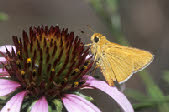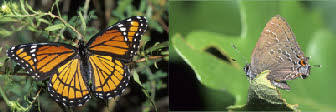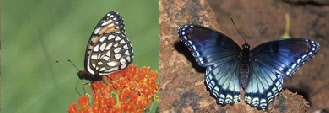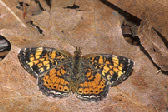The Butterflies of the World Foundation
A Non-





Question Mark
Polygonia interrogationis, Fabricius, 1798
Subfamily Nymphalinae
Tribe Nymphalini
Taxonomy
The family Nymphalidae is the largest butterfly family and includes about 6,000 species which are further divided up into 12 subfamilies. The common name for the family is the Brushfoots or Brushfooted Butterflies. This strange name is because the first pair of legs are significantly reduced, sometimes to mere stubs, and look like little brushes. Some of the most common and well known species are in this group such as the Monarch, Red Admiral, Blue Morpho and Painted Lady. Some of the longest lived butterflies are in this family with some species living over 10 months as adults. The Brushfoots are distributed worldwide, with the highest diversity found in the tropics. With this variety, there is also quite a difference in behavior, adult food choices and habitat preference from species to species.
All photographs, artwork, text and website design are the property of The Butterflies of the World Foundation (unless otherwise stated) and are protected under national and international copyright laws. Photographs, artwork or text on this website may not be reproduced in any way without prior written consent of The Butterflies of the World Foundation.
Polygonia interrogationis, one half mile south of Lexington Wildlife Management Area,
Cleveland County, Oklahoma, 5 October 2005 Ref #:
I-

Polygonia interrogationis, Little Yellowstone Park, Barnes County, North Dakota,
7 August 2004 Ref
#: I-

Polygonia interrogationis, one half mile south of Lexington Wildlife Management Area,
Cleveland County, Oklahoma, 11 May 2007 Ref
#: I-

Polygonia interrogationis, Little Yellowstone Park, Barnes County, North Dakota,
7 August 2004 Ref
#: I-

Polygonia interrogationis, one half mile south of Lexington Wildlife Management Area,
Cleveland County, Oklahoma, 11 May 2007 Ref
#: I-

Polygonia interrogationis, Lake R. C. Longmire, Garvin County, Oklahoma, 17 May 2007
Ref
#: I-

Polygonia interrogationis, Little Yellowstone Park, Barnes County, North Dakota,
7 August 2004 Ref
#: I-

Polygonia interrogationis, one half mile south of Lexington Wildlife Management Area,
Cleveland County, Oklahoma, 11 May 2007 Ref
#: I-

Polygonia interrogationis, Lexington Wildlife Management Area, Cleveland County,
Oklahoma, 16 May 2010 Ref
#: I-
General Information:
Polygonia interrogationis belongs to the subfamily Nymphalinae. Its range is from southern Canada and all of the eastern United States except peninsular Florida, then west to the eastern edge of the Rocky Mountains, and south to southern Arizona and Mexico. Its preferred habitat includes wooded areas with some open space, city parks, suburbs and fence rows.
Lifecycle:
The larval food source includes several trees and plants such as American elm, Ulmus americanus, red elm, Ulmus rubra, hackberry, Celtis sp., Japanese hop, Humulus japonicus, nettles, Urtica sp., and false nettle, Boehmeria cylindrica. Males find females by perching on leaves or tree trunks in the afternoon, pugnaciously flying to chase other insects, birds, even butterfly photographers. Females lay eggs singly or stacked under leaves of plants that are usually not the hosts. Caterpillars must find a host plant and they then eat leaves and live alone. Adults of the winter form hibernate with some staying in the north, and many others migrating to the south.

Two Question Marks, Polygonia interrogationis, along with one Hackberry Emperor,
Asterocampa celtis, working their way down to a sap flow next to a poison ivy vine
on a post oak. There are a cluster of other butterflies directly below the Question
Marks. One half mile south of Lexington Wildlife Management Area, Cleveland County,
Oklahoma, 11 May 2007 Ref #: I-

Polygonia interrogationis, larva on Elm, Ulmus sp., one half mile south of Lexington
Wildlife Management Area, Cleveland County, Oklahoma, 7 April 2012 Ref
#: I-

Polygonia interrogationis, Pontotoc Ridge Preserve, Pontotoc County, Oklahoma, 18
April 2012 Ref
#: I-

Polygonia interrogationis, larvae on hackberry, Celtis sp., Lexington Wildlife Management
Area, Cleveland County, Oklahoma, 12 May 2012 Ref
#: I-

Polygonia interrogationis, larva on hackberry, Celtis sp., Lexington Wildlife Management
Area, Cleveland County, Oklahoma, 12 May 2012 Ref #:
I-

Polygonia interrogationis, larva on hackberry, Celtis sp., Lexington Wildlife Management
Area, Cleveland County, Oklahoma, 12 May 2012 Ref #:
I-

Polygonia interrogationis, larva on hackberry, Celtis sp., Lexington Wildlife Management
Area, Cleveland County, Oklahoma, 12 May 2012 Ref #:
I-

Polygonia interrogationis, larvae on hackberry, Celtis sp., Lexington Wildlife Management
Area, Cleveland County, Oklahoma, 12 May 2012 Ref #:
I-

Polygonia interrogationis, pupa on Elm, Ulmus sp., Lexington Wildlife Management
Area, Cleveland County, Oklahoma, 31 May 2012 Ref
#: I-

Polygonia interrogationis, Lexington Wildlife Management Area, Cleveland County,
Oklahoma, 2 June 2012 Ref
#: I-